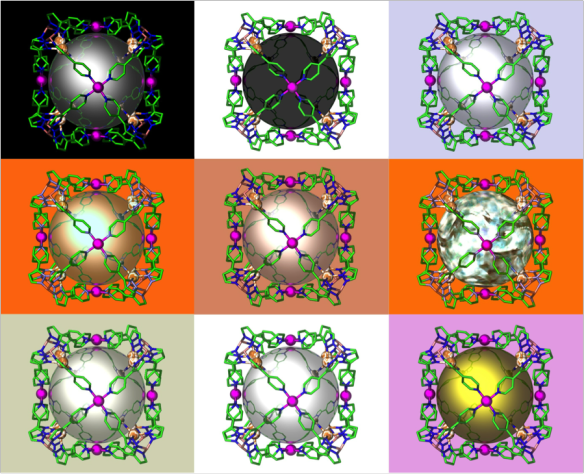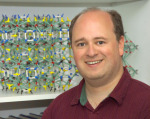Nanoballs – synthesis for the lazy
What does it look like?

What is it?
A feature of supramolecular chemistry is "self-assembly". Molecules are designed to come together and interact in particular ways to form larger assemblies in a single step. This allows the easy synthesis of complicated structures that would normally be very difficult and time consuming to achieve using traditional synthesis, where multiple steps are required, each step forming a single bond at a time. Imagine putting a pile of Lego bricks in a cement mixer and pulling out a perfectly assembled Lego house when the mixer was finished!
A particularly beautiful example of self-assembly is the formation of the "nanoballs" shown above. These result from the reaction of no less than fourteen metal atoms and eight "scorpionate" ligands (so-named because they "attack" and bind a metal with three different arms, much like a scorpion attacks with two claws and a stinging tail). The nanoballs are almost three nanometers in diameter, and pack together in crystals with different arrangements that depend on the solvent they crystallise from and the counterions used to balance the charge on the nanoball. The modular nature of the synthesis also allows variations to be made with different metal ions, though this does not change the packing arrangement.
The ability to change the solvent, counterions and metals means that different varieties of the nanoballs can be formed, and different applications can be targeted. With iron they show a property known as spin crossover – changing the temperature leads to the iron atoms changing from a high spin magnetic state to a low spin one. This leads to a change in the magnetic moment, and to the colour of the crystal. If a green laser is shone on it in the low spin state it will flip back to the high spin state; a red laser will then take it back down to low spin, meaning the iron nanoball is in fact a 3 nanometre molecular switch.
Porous phases are also achieved with perchlorate counterions; they will absorb hydrogen and carbon dioxide, but not methane (indicating a level of selectivity in the gas sorption). The materials will also absorb a range of solvent vapours, and in the case of iron this also changes the magnetic properties. Ongoing work has also indicated that the copper nanoballs can act as catalysts, making certain reactions go faster and along certain pathways.
So these are truly versatile molecules, and the best bit is that Nature does most of the hard work of making them. Some may say that this is just lazy; I say it's simply clever design.
Where did the structure come from?
"A Nano-Scale Molecular Switch Triggered by Thermal, Light, and Guest Perturbation", M. B. Duriska, S. M. Neville, B. Moubaraki, J. D. Cashion, G. J. Halder, K. W. Chapman, C. Balde, J.-F. Létard, K. S. Murray, C. J. Kepert and S. R. Batten, Angew. Chem. Int. Ed., 2009, 48, 2549. DOI: 10.1002/anie.200805178
CCDC Deposition code: 706263






